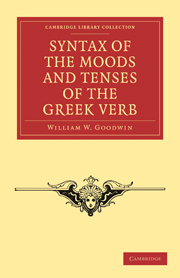Book contents
- Frontmatter
- PREFACE TO THE SECOND EDITION
- Contents
- CHAPTER I GENERAL VIEW OF THE MOODS
- CHAPTER II USE OF THE TENSES
- CHAPTER III THE PARTICLE ῞AN
- CHAPTER IV USE OF THE MOODS
- CHAPTER V THE INFINITIVE
- CHAPTER VI THE PARTICIPLE
- CHAPTER VII VERBAL ADJECTIVES IN -τέος
- APPENDIX I
- APPENDIX II
- INDEX TO EXAMPLES
- ENGLISH INDEX
- GREEK INDEX
CHAPTER V - THE INFINITIVE
Published online by Cambridge University Press: 07 September 2011
- Frontmatter
- PREFACE TO THE SECOND EDITION
- Contents
- CHAPTER I GENERAL VIEW OF THE MOODS
- CHAPTER II USE OF THE TENSES
- CHAPTER III THE PARTICLE ῞AN
- CHAPTER IV USE OF THE MOODS
- CHAPTER V THE INFINITIVE
- CHAPTER VI THE PARTICIPLE
- CHAPTER VII VERBAL ADJECTIVES IN -τέος
- APPENDIX I
- APPENDIX II
- INDEX TO EXAMPLES
- ENGLISH INDEX
- GREEK INDEX
Summary
§ 90. The Infinitive mood expresses the simple idea of the verb, without limitation of number or person. It has the force of a neuter verbal noun, and as such it may take the neuter of the article in all its cases.
It has at the same time the attributes of a verb, so that (even when it takes the article) it may have a subject, object, and other adjuncts; and, further, it is qualified not by adjectives, but by adverbs.
§ 98. The Infinitive may as nominative be the subject of a finite verb, or as accusative be the subject of another Infinitive. The Infinitive is especially common as the subject of an impersonal verb, or of ἐστί. It may also be a predicate nominative, or it may stand in apposition with a substantive.
Such Infinitives stand regularly without the article; but if they are to be especially prominent as containing the leading idea of the sentence, the article may be used. E. g.
Συνέβη αὐτῷ ἐλθεῖν, it happened to him to go. Οὐκ ἔνεστι τοῦτο ποιῆσαι. Ἁδύνατόν ἐστι τοῦτο ποιῆσαι. Ἑξῆν μένειν. Δεῖ αὐτὸν μένειν. Οὐ μὲν γάρ τι κακὸν βασιλευέμεν, for it is no bad thing to be a king.
- Type
- Chapter
- Information
- Syntax of the Moods and Tenses of the Greek Verb , pp. 188 - 212Publisher: Cambridge University PressPrint publication year: 2010First published in: 1867

